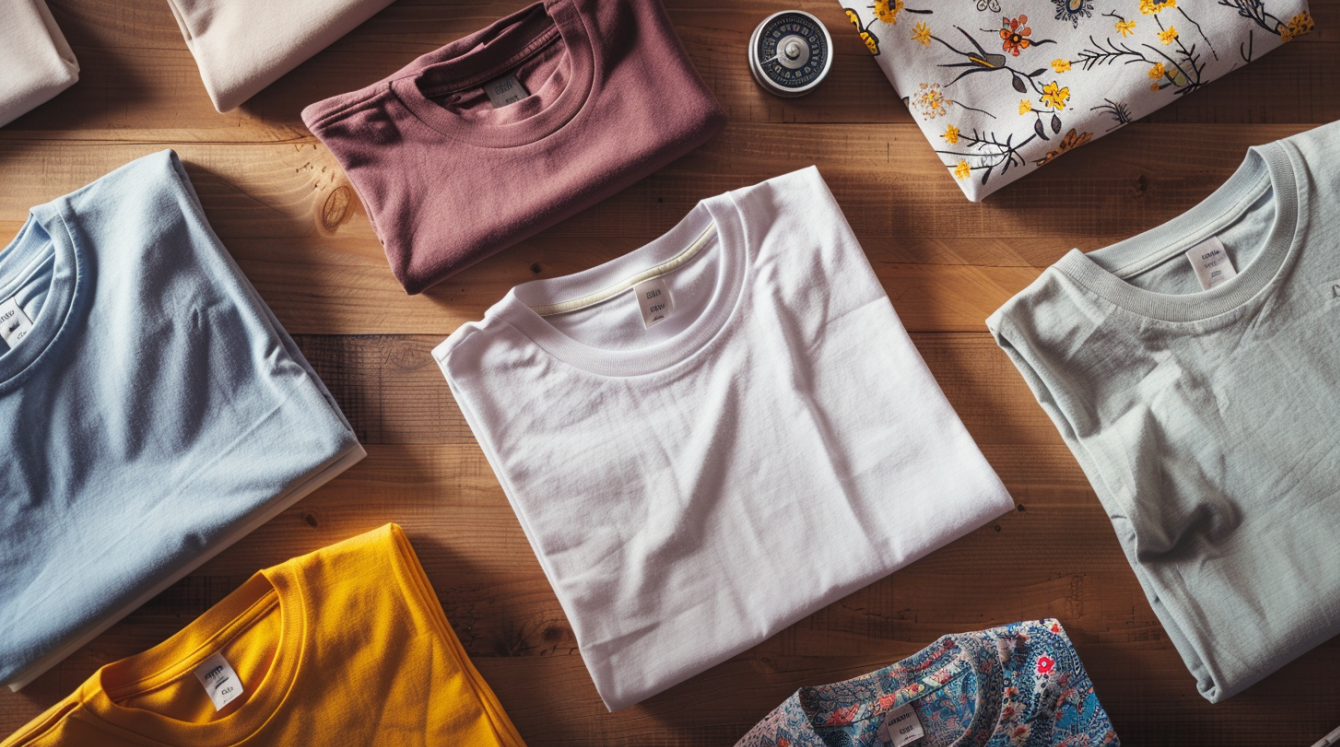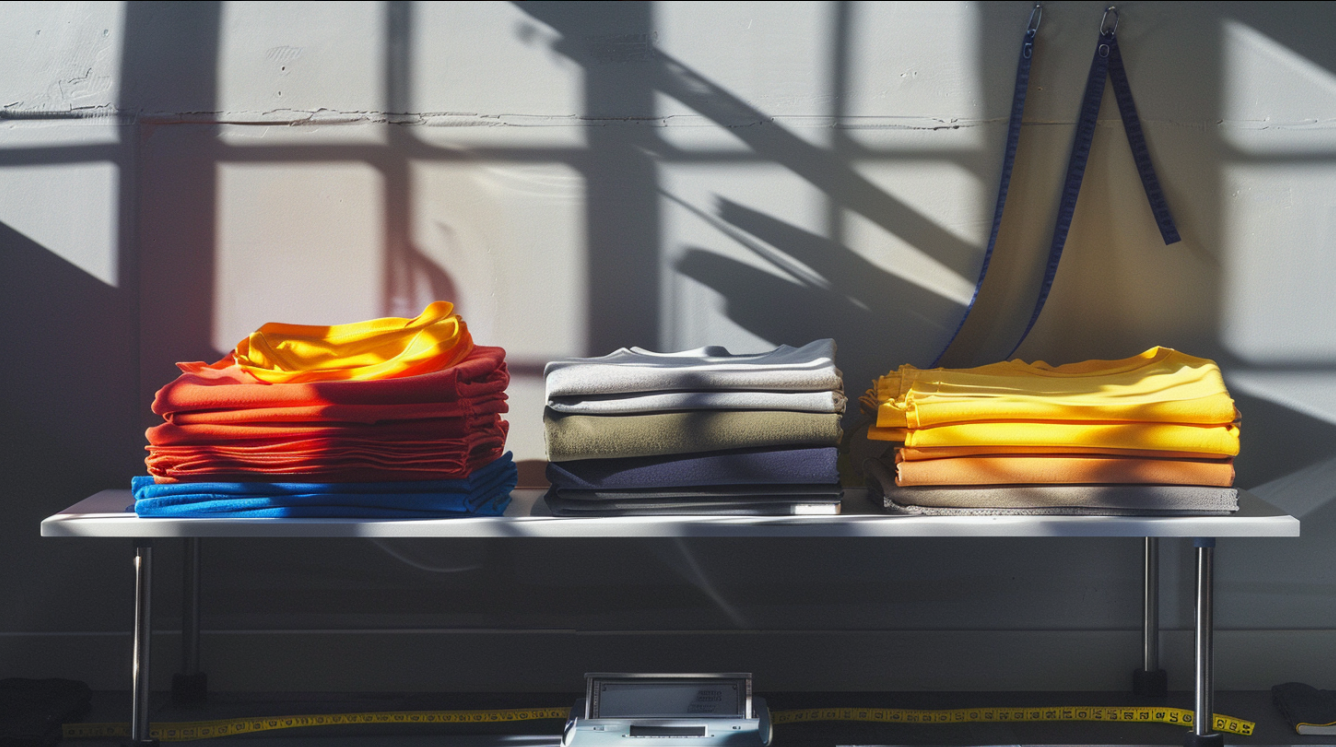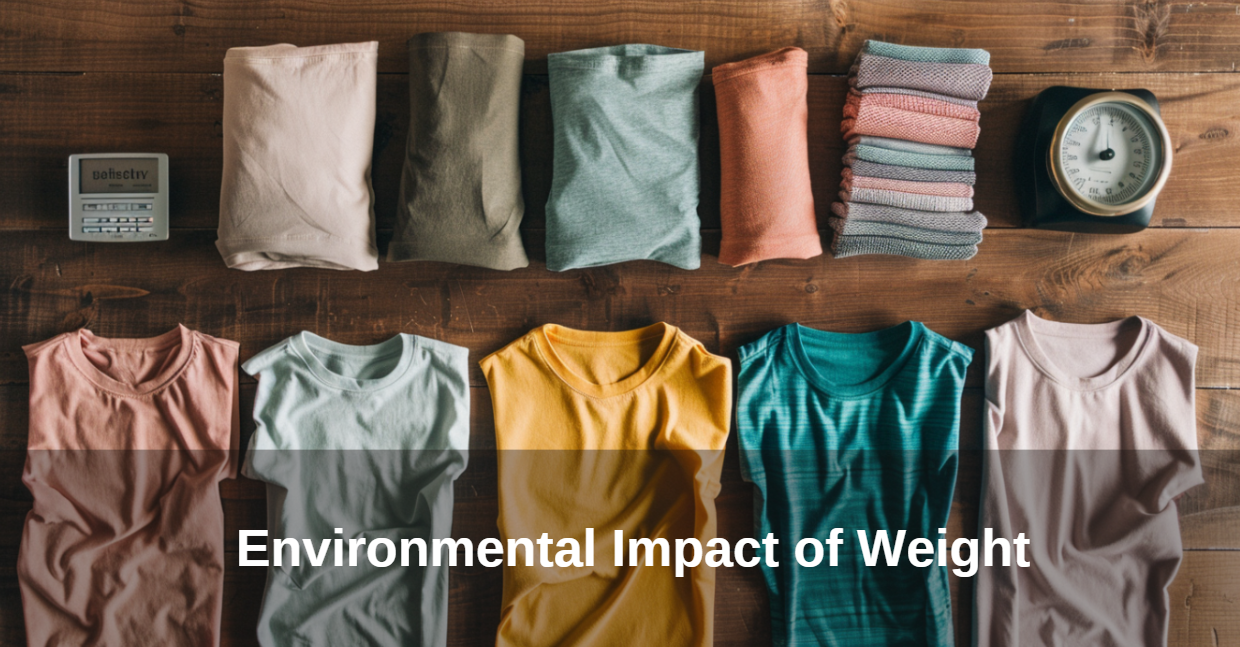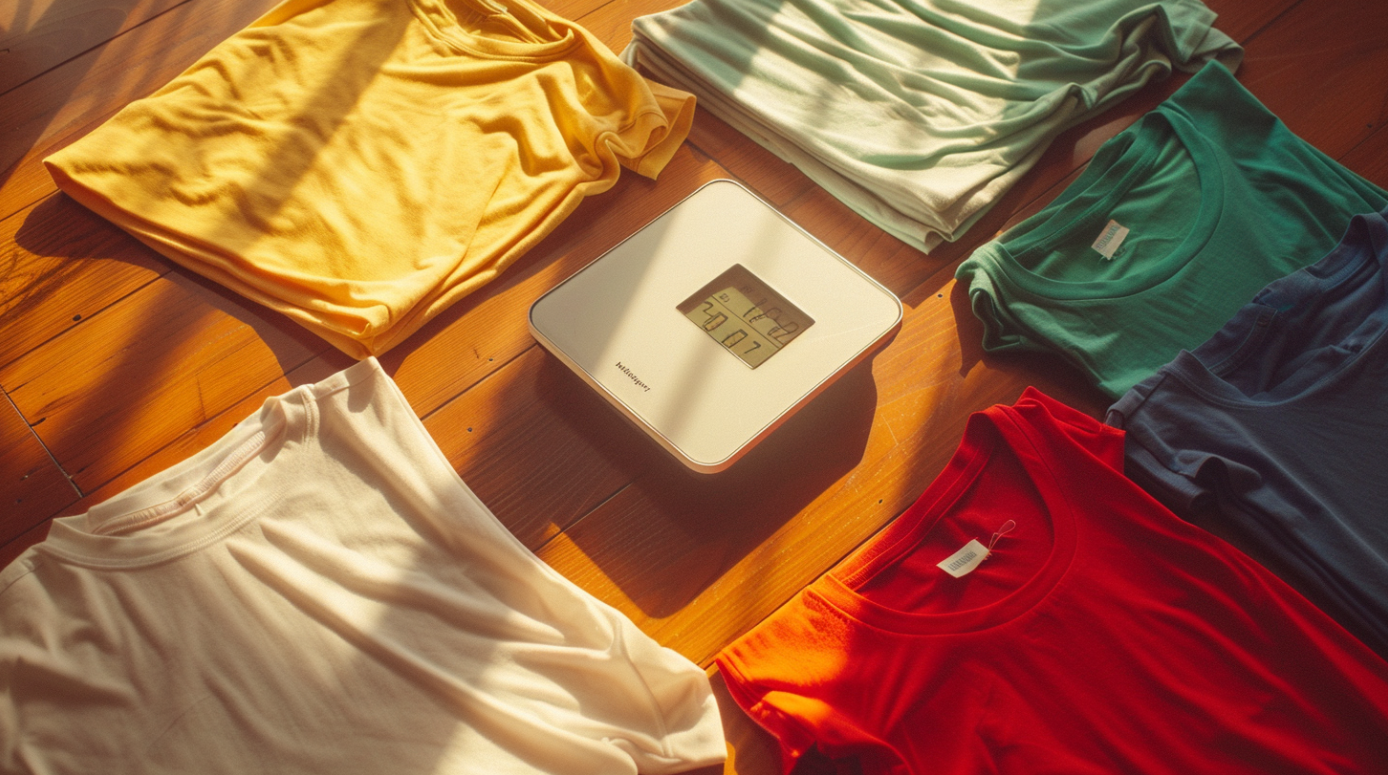How Much Does a T Shirt Weigh? Like the elusive weight of a feather in the wind, the weight of a T-shirt can be surprisingly variable. You might think all T-shirts are created equal, but the truth is, several factors influence their heft, from material type to design details of T-shirt. If you’ve ever wondered how these elements come together to affect not just comfort but also practicality, you’re not alone. Understanding the nuances of T-shirt weight can offer insights into both personal preference and broader applications, leaving you with a lot to reflect upon before your next purchase.
Key Takeaways
- Cotton T-shirts typically weigh between 4.5 to 6 ounces, while polyester T-shirts range from 3 to 5 ounces.
- Blended fabric T-shirts usually weigh around 3.5 to 5.5 ounces, balancing weight and comfort.
- Basic crew neck T-shirts generally weigh about 5-6 ounces, while graphic tees can weigh between 6-8 ounces.
- Fashion fit or oversized styles may weigh between 7-10 ounces due to additional fabric requirements.
- Factors like embellishments, size, and fabric density significantly influence a T-shirt’s overall weight.
Average T-Shirt Weight- The Answer You Want To Know About
When considering the average weight of a T-shirt, how does fabric composition influence its heft? The weight of a T-shirt primarily hinges on its materials. Common T-shirt materials include cotton, polyester, and blends. Each type contributes differently to the overall weight.
Cotton, known for its softness and breathability, typically results in heavier T-shirts, often weighing between 4.5 to 6 ounces per shirt. On the other hand, polyester tends to be lighter, with many shirts weighing around 3 to 5 ounces. Blended fabrics, combining cotton and polyester, present a middle ground, generally falling in the 3.5 to 5.5-ounce range.
These weight differences aren’t just trivial; they affect the garment’s feel, durability, and even cost. A heavier T-shirt might provide a more substantial feel and better durability, while lighter options often offer increased breathability and comfort, especially in warm conditions. When selecting a T-shirt, knowing how fabric composition impacts its weight can guide your choice, ensuring you find one that meets your needs for style and function.
Factors Affecting Weight of T-Shirt
Several factors influence the weight of a T-shirt beyond just fabric composition. One significant aspect is fabric density, which refers to the weight of the fabric per unit area. Higher density fabrics typically weigh more because they contain more material in the same area. Consequently, when choosing a T-shirt, you should consider how the density affects the overall weight, especially if you’re looking for something lightweight or more substantial.
Garment construction also plays an essential role in determining the weight. The stitching techniques, seam styles, and the number of layers used during production can all add to the final weight of the T-shirt. For instance, a T-shirt with reinforced seams or additional fabric panels may weigh more than a simpler design.
Moreover, any embellishments, such as prints or embroidery, can increase the weight as well. When evaluating your options, keep these factors in mind. Understanding the interplay between fabric density and garment construction will help you make a more informed choice about the T-shirt that best fits your needs.
Material Types and Their Weights
Choosing the right material for a T-shirt can greatly impact its overall weight and feel. Different fabrics exhibit varying fabric densities, which directly affects the weight of the garment. Cotton, for instance, is a popular choice due to its moderate density, typically weighing around 4.5 to 6 ounces per yard. In contrast, polyester is lighter, often weighing between 3.5 to 5 ounces per yard, allowing for a more breathable and comfortable experience.
When considering weight distribution, the weave and thickness of the fabric also play significant roles. A tighter weave increases fabric density, resulting in a heavier T-shirt, while a looser weave can create a lighter feel without sacrificing durability. Blends, such as cotton-polyester, can optimize both weight and comfort, allowing for a balanced distribution of weight that enhances wearability.
Ultimately, understanding the material types and their weights enables you to select a T-shirt that meets your specific needs for comfort and durability. By analyzing fabric density and weight distribution, you can make informed choices that align with your preferences and lifestyle.
Weight Comparison: Different Styles
When comparing the weight of different T-shirt styles, you’ll notice that fabric type markedly influences overall weight. Additionally, the size of the shirt plays a vital role, as larger sizes inherently weigh more. Finally, design features such as embellishments or additional layers can affect the weight, making it essential to take into account these factors in your assessment.
Fabric Type Differences
One might be surprised by how much fabric type influences the weight of a T-shirt. Different materials bring unique properties that affect not only the feel but also the overall weight of the garment. When you consider fabric types, you’ll notice distinct variations:
- 100% Cotton: Known for its softness and breathability, this fabric typically weighs more due to its density. A standard cotton T-shirt is often heavier than its synthetic counterparts.
- Cotton Blends: Combining cotton with polyester reduces weight while maintaining comfort. The polyester properties add durability and moisture-wicking capabilities, making these shirts lighter and ideal for athletic wear.
- 100% Polyester: This fabric is the lightest among the three. Its synthetic nature allows for a thinner weave, resulting in a notably lower weight. Polyester’s moisture resistance makes it a popular choice for active wearers.
Understanding these fabric distinctions helps you make informed choices when selecting a T-shirt. Whether you prefer the heft of cotton or the lightweight nature of polyester, the fabric type can dramatically affect your wearing experience.
Size Impact on Weight
Considering the size of a T-shirt significantly influences its weight, as larger dimensions require more fabric. When you examine size variations, you’ll find that T-shirts are typically categorized into small, medium, large, and extra-large. Each size increment adds a specific amount of fabric, which directly correlates to the overall weight.
For instance, a standard small T-shirt might weigh around 5 ounces, while an extra-large version can weigh up to 7 ounces or more. This difference stems from the added fabric that not only covers a larger area but also affects the weight distribution across the garment.
In practical terms, if you’re considering a bulk order for a promotional event, understanding these weight differences can impact shipping costs and storage requirements. Additionally, if you’re trying to find the right size for a comfortable fit, you should take into account that weight can also influence how the fabric drapes and feels against your skin.
Ultimately, when selecting a T-shirt, be mindful of how size variations affect weight and consider how this might align with your specific needs.
Design Features Consideration
Design features play an essential role in determining the weight of a T-shirt, as different styles utilize varying amounts of fabric and construction techniques. When you consider the design aesthetics, it’s vital to recognize how these choices impact the overall heft of the garment. Here are three key styles to compare:
- Basic Crew Neck: Typically made from lightweight cotton, this style often weighs around 5-6 ounces. Its simplicity reduces fabric use, keeping it lightweight.
- Graphic Tee: Incorporating various printing techniques, such as screen printing or direct-to-garment, can add weight. A graphic tee may weigh between 6-8 ounces, depending on the complexity and type of print.
- Fashion Fit or Oversized: Designed for a trendy look, these T-shirts often utilize additional fabric and may include heavier blends. You can expect these to weigh anywhere from 7-10 ounces.
Practical Uses of T-Shirt Weight
Understanding the weight of a t-shirt is essential for several practical applications. It directly impacts your shipping costs, influences your choice of fabric, and affects packing and storage efficiency. By analyzing these factors, you can optimize your inventory management and reduce overall expenses.
Shipping Costs Consideration
When calculating shipping costs for T-shirts, their weight plays a crucial role in determining overall expenses. Understanding the weight allows you to choose the most efficient shipping methods and achieve cost optimization. Here are three key considerations that can help you manage shipping costs effectively:
- Weight Class: Shipping carriers often categorize packages based on weight ranges. Knowing your T-shirt’s weight helps you select the appropriate class to avoid unnecessary charges.
- Bulk Shipping: If you’re sending multiple T-shirts, consider the cumulative weight. Grouping them can lead to economies of scale, allowing you to negotiate better rates with carriers.
- Shipping Zones: Different regions have varying shipping rates. By calculating the total weight of your T-shirts, you can better estimate costs based on the destination, helping you decide which shipping method provides the best value.
Fabric Choice Implications
The weight of a T-shirt greatly influences your choice of fabric, impacting not only comfort but also functionality and performance. When you select a lightweight fabric, you might enjoy a breezy feel, ideal for warm weather. However, lighter fabrics often sacrifice fabric durability; they may wear out more quickly or become prone to pilling after multiple washes. Conversely, heavier fabrics tend to offer increased durability, ensuring the T-shirt withstands wear and tear over time.
Color retention is another critical factor linked to fabric weight. Heavier, denser fabrics generally hold dyes better, resulting in vibrant colors that resist fading. If you’re looking for a T-shirt that maintains its appearance after numerous washes, opting for a fabric with a greater weight can be beneficial.
Packing and Storage Efficiency
T-shirt weight plays a significant role in packing and storage efficiency, influencing how many shirts you can fit into a suitcase or drawer. Understanding the weight of your t-shirts allows you to optimize your packing methods and storage solutions effectively.
Consider these factors when evaluating your packing strategy:
- Layering Technique: Heavier shirts may require more careful layering to prevent crushing lighter fabrics, optimizing space usage.
- Rolling vs. Folding: Rolling lightweight shirts can save space and minimize creasing, while folding heavier ones may be necessary for stability.
- Compartmentalization: Using packing cubes designed for varying weights can help segregate your t-shirts, ensuring you maximize both packing density and accessibility.
Shipping Considerations
Understanding shipping factors for t-shirts involves several elements, particularly weight and packaging. When you’re choosing shipping methods, the weight of your t-shirts plays a significant role. Most carriers have specific weight limits that can affect your shipping options and costs. For instance, standard ground shipping may be more economical for heavier packages, while expedited options might become cost-prohibitive.
You also need to take into account how packaging can influence the overall weight. Using lightweight materials for packaging can help you stay within weight limits, allowing for more efficient shipping. It’s important to weigh the t-shirts along with their packaging before finalizing your shipping method. This guarantees you’re not exceeding any weight restrictions that could lead to additional fees or delays.
Additionally, understanding the dimensional weight concept is vital. Carriers often charge based on both actual weight and dimensional weight, which is calculated from the package size. Therefore, optimizing your packaging size can minimize costs. By carefully evaluating these shipping factors, you can streamline your shipping process and maintain cost efficiency, guaranteeing timely delivery while adhering to weight limits.
Environmental Impact of Weight
Weight plays an essential role in the environmental impact of t-shirt production and shipping. When you consider the carbon footprint associated with t-shirts, the weight directly influences transportation emissions and resource consumption. Heavier garments require more energy to transport, increasing overall emissions. To visualize this impact, think about:
- Shipping Costs: Heavier t-shirts result in higher fuel consumption, leading to elevated shipping costs and environmental strain.
- Resource Allocation: More weight can mean more resources, whether regarding raw materials or energy used during production, further amplifying the carbon footprint.
- Waste Management: Larger quantities of heavier fabrics often lead to increased waste during both production and disposal, complicating recycling efforts.
To mitigate these effects, adopting sustainable practices is paramount. Lighter, responsibly sourced materials can reduce your t-shirt’s weight, thereby minimizing emissions throughout its lifecycle. By choosing eco-friendly fabrics and efficient shipping methods, you can actively contribute to lowering the carbon footprint associated with t-shirt production. In this manner, you’re not just wearing a garment; you’re making a statement about environmental responsibility.
Tips for Measuring T-Shirt Weight
Measuring the weight of a t-shirt accurately requires a systematic approach to guarantee you gather precise data. Start by selecting an appropriate scale; verify it has a minimum capacity of 0.01 grams for scale accuracy. Using a digital kitchen scale can also provide you with more reliable results than a mechanical scale.
Next, prepare your t-shirt for weighing. Make sure it’s clean and dry, as moisture can add unnecessary weight. Lay the t-shirt flat on a smooth, stable surface to prevent any distortion during the measurement.
When employing measuring techniques, such as weighing the t-shirt alone, avoid including additional items like tags or accessories. Place the t-shirt directly on the scale, ensuring it doesn’t touch surrounding objects that could affect the reading. Take multiple measurements, ideally three, and calculate the average to improve accuracy.
Finally, document your findings clearly. This approach not only enhances your measurement reliability but also allows for better comparisons across different t-shirts. By following these tips, you’ll verify that you obtain an accurate weight for any t-shirt you measure.
Frequently Asked Questions
Can a T-Shirt Weight Affect Its Comfort Level?
Isn’t it fascinating how weight influences comfort? A t-shirt’s weight impacts its fabric softness and can restrict your body movement. Lighter fabrics often enhance comfort, allowing freedom and ease during your daily activities.
How Does Weight Influence T-Shirt Durability?
Weight greatly influences t-shirt durability. In a weight comparison, heavier fabrics often indicate higher quality, leading to increased resistance against wear and tear. Consequently, considering fabric quality helps guarantee your t-shirt withstands regular use effectively.
Is There a Standard Weight for Promotional T-Shirts?
When you’re considering promotional materials, there isn’t a strict standard weight for t-shirts. However, most manufacturers provide weight specifications typically ranging from 4.5 to 6 ounces, balancing durability and comfort for effective branding.
Do Heavier T-Shirts Cost More to Produce?
Heavier t-shirts often incur higher production costs due to increased material quality and quantity. Manufacturers must account for this when pricing, as the choice of fabric and weight directly influences overall expenses and product value.
How Do I Choose a T-Shirt Based on Weight?
Choosing a t-shirt’s weight is like selecting a canvas for art; consider fabric types and fit preferences. Lightweight options offer breathability, while heavier fabrics provide durability. Balance comfort and style to suit your needs perfectly.
Conclusion
In conclusion, understanding a T-shirt’s weight isn’t just about numbers; it’s about the blend of materials and craftsmanship that shape your experience. Imagine holding a soft, lightweight cotton tee versus a sturdier, embellished style—each offers a distinct feel and purpose. By considering weight alongside comfort and durability, you can make informed choices, ensuring your wardrobe is both functional and stylish. As you shop, remember: a T-shirt’s weight can greatly influence its practicality in your daily life.

















